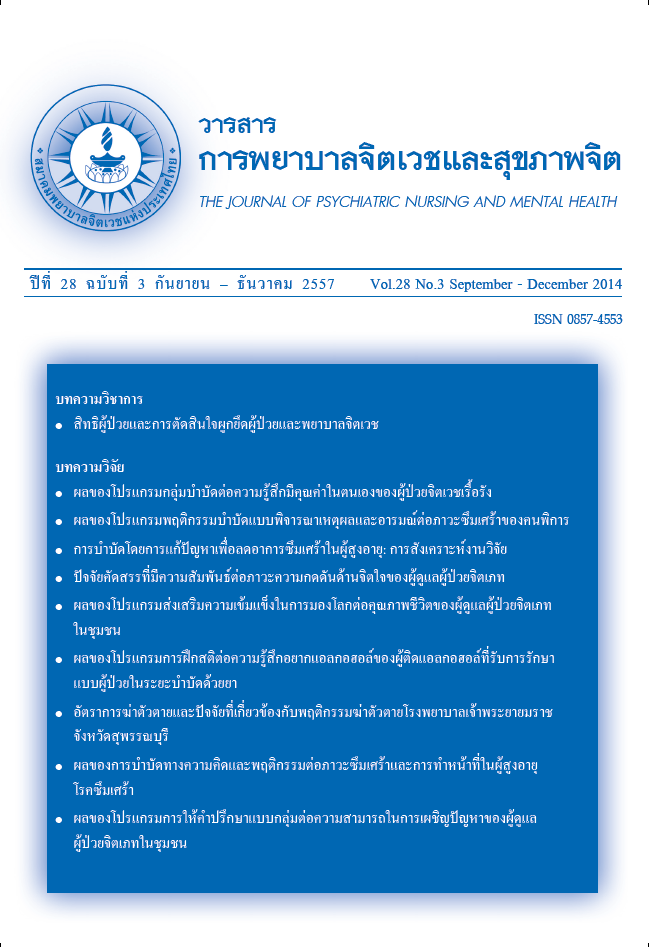อัตราการฆ่าตัวตายและปัจจัยที่เกี่ยวข้องกับพฤติกรรมฆ่าตัวตายโรงพยาบาลเจ้าพระยายมราช จังหวัดสุพรรณบุรี RATE OF SUICIDE AND FACTORS RELATED TO SUICIDAL BEHAVIOR AT CHAOPHAYAYOMMARAT HOSPITAL SUPHANBURI PROVINCE
Main Article Content
บทคัดย่อ
วัตถุประสงค์: วัตถุประสงค์ของงานวิจัยเชิงพรรณนาแบบศึกษาย้อนหลังนี้เพื่อศึกษาอัตราการฆ่าตัวตายและปัจจัยที่เกี่ยวข้องกับการฆ่าตัวตายในผู้มีพฤติกรรมการฆ่าตัวตาย
วิธีการศึกษา: เก็บรวบรวมข้อมูลย้อนหลัง3 ปี (2553-2555) จากรายงานการเฝ้าระวังภาวะเสี่ยงต่อการฆ่าตัวตาย (รง 506 DS) ซึ่งเป็นข้อมูลของผู้มีพฤติกรรมการฆ่าตัวตายที่มารับบริการแผนกอุบัติเหตุฉุกเฉินโรงพยาบาลเจ้าพระยายมราช จังหวัดสุพรรณบุรี จำนวน 374 คน และข้อมูลจากการสัมภาษณ์เชิงลึกผู้พยายามฆ่าตัวตายที่เข้ารักษา ณ หอผู้ป่วยอายุรกรรม จำนวน 5 ราย วิเคราะห์ข้อมูลโดยใช้สถิติบรรยาย
ผลการศึกษา: ผลการวิจัย พบว่า กลุ่มผู้ฆ่าตัวตายสำเร็จเป็นเพศชายมากกว่าเพศหญิงคิดเป็นอัตราส่วน 2.9:1 ขณะที่กลุ่มผู้พยายามฆ่าตัวตายเป็นเพศหญิงมากกว่าเพศชายคิดเป็นอัตราส่วน 1.2:1 ทั้งกลุ่มผู้ฆ่าตัวตายสำเร็จและกลุ่มผู้พยายามฆ่าตัวตายส่วนใหญ่มีอาชีพรับจ้างหรือผู้ใช้แรงงาน ขณะที่ผู้ฆ่าตัวตายสำเร็จส่วนใหญ่อยู่ในวัยกลางคนหรือวัยทำงาน ผู้พยายามฆ่าตัวตายส่วนใหญ่เป็นกลุ่มวัยรุ่นและวัยทำงานตอนต้น กลุ่มผู้ฆ่าตัวตายสำเร็จมีประวัติการทำร้ายตนเองซ้ำมากกว่ากลุ่มผู้พยายามฆ่าตัวตายในอัตราส่วน 2.9:1 และทั้งกลุ่มผู้พยายามฆ่าตัวตาย และกลุ่มผู้ฆ่าตัวตายสำเร็จส่วนใหญ่มาจากตำบลที่มีเขตติดต่อกับพื้นที่เขตเทศบาลเมืองฯ ส่วนระดับภาวะซึมเศร้าพบว่า กลุ่มผู้พยายามฆ่าตัวตายมีภาวะซึมเศร้า คิดเป็นร้อยละ 33.13 ในจำนวนนี้ส่วนใหญ่มีภาวะซึมเศร้าอยู่ในระดับเล็กน้อยคิดเป็นร้อยละ 64.86 นอกจากนี้กลุ่มผู้ฆ่าตัวตายสำเร็จมักใช้วิธีการผูกคอตนเอง ขณะที่กลุ่มผู้พยายามฆ่าตัวตายส่วนใหญ่ใช้วิธีกินยาเกินขนาด ด้านสาเหตุกระตุ้นในการทำร้ายตนเองของกลุ่มผู้พยายามฆ่าตัวตาย พบว่า ส่วนใหญ่จากปัญหาทะเลาะกับคนใกล้ชิด คิดเป็นร้อยละ 37.31รองลงมาคือ ปัญหาน้อยใจ ถูกดุด่า ตำหนิคิดเป็นร้อยละ 22.39 ส่วนกลุ่มผู้ฆ่าตัวตายสำเร็จจะมีปัญหาการใช้สารเสพติดโดยเฉพาะบุหรี่และสุรา
สรุป: ผลการสศึกษานี้แสดงให้เห็นว่าการที่จะลดอัตราการฆ่าตัวตายนั้นควรเสริมสร้างสัมพันธภาพที่ดีในครอบครัว และลดความขัดแย้งในครอบครัว
Objectives: The purposes of this descriptive research and retrospective study were to examine the rate of suicide and the factors related to suicidal behavior.
Methods: Data were obtained from the suicide surveillance report (report 506 DS)between 2010 to 2012, 374 patients with suicidal behavior who visit at the emergency department of Chaophayayommarat hospital, and from in-depth interviews using interview protocols with five suicide attempters who admitted in general medicine inpatient ward. The data were analyzed using descriptive statistics.
Results: The findings revealed that the ratio of completed suicide between male and female was 2.9:1. Women were more likely to attempt suicide than men, the ratio was 1.2:1.The majority of persons who completed suicide were employee, in middle age, had a history of repeated self-harm, and lived in district area.The majority of persons who attempted suicide were employee or labor, in adolescence and early adulthood, and lived in the district area. The completed suicide group had a history of repeated self harm more than the attempted suicide group. It was found that 33.13% of suicide attempters had depression and mostly were in mild level (64.86%). In addition, most of the completed suicide group harmed the mselves by hanging, while most of attempted suicide persons took the form of drug overdoses. The causes leading to self-harm in attempted suicide group were arguing with their intimates (37.31%) and being hurt by blame (22.39%). In completed suicide group, the highest cause was involved with addictive substances, especially tobacco and alcohol.
Conclusion: Results from this study suggest that in order to reduce suicide, relationship in family should be promoted and conflict in family should be reduced.
Article Details
บทความที่ได้รับการตีพิมพ์แล้ว เป็นลิขสิทธิ์ของสมาคมพยาบาลจิตเวชแห่งประเทศไทย


